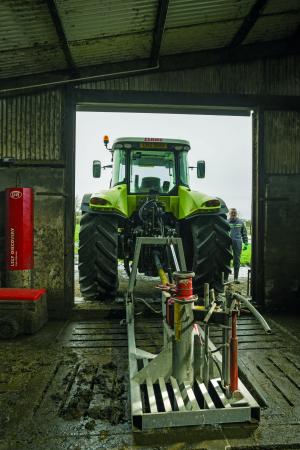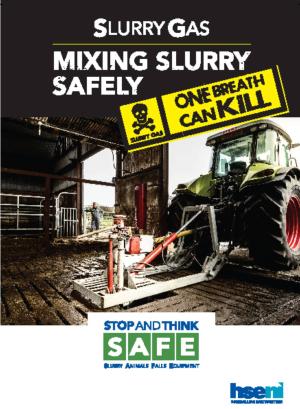Slurry - working safely with slurry
Slurry is one of the four main causes of death and serious injury on Northern Ireland's farms.
Working safely with slurry

Drowning has also occurred where people, exposed to the fumes, have fallen through openings into tanks. Don’t let it happen on your farm.
Before you start
Before working with or near slurry take a moment to Stop and Think!
- think about the job you are going to do and make preparations to do the entire task safely
- think about vital preparations - check that the tractor/tanker are in good repair, brakes and tyres in good condition and if they have to be positioned above the tank, make sure the slats can take the weight, particularly if using new, heavier machinery
- think about ensuring all openings are covered to prevent a fall into the slurry tank
- keep animals and children well away when working with slurry - you must remove all livestock from the shed before mixing starts
Remember, slurry gas is heavier than air and during mixing will settle in a cloud over the top of the slurry - bending down into the gas cloud for even a few moments can cause unconsciousness. Covered openings save lives.
The risk is variable and difficult to predict. You may not have noticed any problems until now but the gas is always there during mixing.
A combination of conditions can easily result in you and your animals suddenly being in serious danger.
Should you risk leaving your livestock in the shed during a mixing operation your insurance company may not cover you for loss of livestock should an incident occur.
Slurry gases
Slurry gas is a mixture of gases including methane, carbon dioxide, ammonia and hydrogen sulphide, all produced by bacteria during the decomposition of slurry.
All these gases are unpleasant; some are also poisonous as well as being flammable.
Hydrogen Sulphide
The most dangerous is hydrogen sulphide - extremely poisonous to people and animals.
A high concentration knocks out your sense of smell, causing difficulty in breathing, then disorientation.
After only a few breaths, collapse and death can occur. This gas rapidly displaces air from the lungs and affects the nervous system.
Toxic release
Some gas may bubble to the surface but most remains dissolved in the liquid in a similar way to gas held within a bottle of fizzy drink. As soon as slurry mixing starts, the gas is released rapidly.
The addition of other materials such as silage effluent may increase the quantity of gas produced.

Mixing slurry
At high concentrations it is not possible to smell hydrogen sulphide. The gas is generally given off in large volumes very soon after mixing starts in any area of the tank. The first 30 minutes are the most dangerous. As mixing continues, the quantity of slurry gas released falls off.
However - each time the pump is repositioned to mix another part of the tank, gas concentration rises again.
Stay out of the building for at least another 30 minutes or longer depending on the size of the tank.
The area should be left to ventilate naturally for at least 30 minutes after the pump has been stopped before re-entering buildings.
Slurry pump - advice
Slurry pumps that are designed to allow the PTO shaft to remain attached to the tractor when the pump is being transported have a high centre of gravity and it is important to follow the advice below:
It is essential that the two lower lift arms on the tractor are properly latched and locked into the two brackets on the slurry pump linkage frame before the top link or PTO shaft are attached. When not in use, it is very important that the pump is parked using the support legs on a HARD, LEVEL surface.
Exposure and effects
Gas concentration is measured, using special equipment, in parts per million of the atmosphere - ppm.
- 20 to 150 ppm - irritation of the eyes and respiratory tract
- 200ppm - headache and dizziness
- above 500ppm is very common in livestock buildings during tank mixing, causing nausea, disorientation and collapse - death is possible if a person remains exposed to this concentration
- above 700ppm - breathing stops and rapid death
Gas concentration meters
Hand held monitors are readily available and can, if properly maintained and calibrated, provide an additional safety precaution. However monitors should always be regarded only as a back-up to a safe system of work, never a substitute.
Pocket-sized meters to measure levels of hydrogen sulphide can be a useful guide before entering a building after mixing is complete to check the gas has had time to disperse. Never rely on a meter at the start of mixing; gas concentration rises so quickly it is dangerous to remain in the building. A meter will not give adequate warning or time to escape.
Some meters need to be calibrated every time they are used and returned to the manufacturer regularly (every three to six months) to be maintained and calibrated.
A facemask will not help
Anyone who enters a slurry tank must wear breathing apparatus with its own air supply. Such work is a specialist operation and is best left to fully trained competent contractors.
The equipment must be regularly maintained and the person entering the tank must be connected by harness and lifeline to two people outside the tank.
Helping someone overcome by gas
If possible, stop the pump and get the person to fresh air, but do not put yourself at risk in the process. If breathing is weak or stopped, artificial respiration may be effective. Get emergency medical attention immediately.
The Stop and Think checklist
Always
- assume hazardous gas is present during mixing
- keep all unnecessary openings to slurry tanks covered
Follow the safe system of work outlined below to stay out of trouble.
- if possible, mix on a windy day
- keep children away from the area at all times when working with slurry
- take all animals out of the building before starting to mix slurry
- open all doors and windows
- use outside mixing points first
- if slats are removed, cover exposed areas of the tank beside the pump/mixer to stop anything falling in
- start the pump/mixer and then stay out of the building for as long as possible - at least 30 minutes or longer depending on the size of the tank
- if you have to go into the building, make sure that another adult who knows what you are doing stays outside and can get help if needed
- if you have to re-enter to move the pump, or change the direction of the pump, leave the building as soon as this is done - do not go back in for as long as possible - at least another 30 minutes or longer depending on the size of the tank.
- once the pump has been stopped you should leave the area to ventilate for at least another 30minutes before re-entering the building
Never
- rely on filter type facemasks
- use gas monitors/meters as a substitute for a safe method of working
- rely on meters at the start of mixing
- have naked flames near slurry, as slurry gas mixture is flammable
- stand close to the pump/exhaust of a vacuum tanker when it is being filled
Remember
There is no safe slurry tank. The gases can kill people and animals almost instantly. Prevent accidents and save lives by always following the safe system of work.